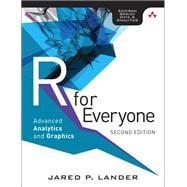Using the open source R language, you can build powerful statistical models to answer many of your most challenging questions. R has traditionally been difficult for non-statisticians to learn, and most R books assume far too much knowledge to be of help. R for Everyone is the solution.
Drawing on his unsurpassed experience teaching new users, professional data scientist Jared P. Lander has written the perfect tutorial for anyone new to statistical programming and modeling. Organized to make learning easy and intuitive, this guide focuses on the 20 percent of R functionality you’ll need to accomplish 80 percent of modern data tasks. Lander’s self-contained chapters start with the absolute basics, offering extensive hands-on practice and sample code. You’ll download and install R; navigate and use the R environment; master basic program control, data import, and manipulation; and walk through several essential tests. Then, building on this foundation, you’ll construct several complete models, both linear and nonlinear, and use some data mining techniques.
By the time you’re done, you won’t just know how to write R programs, you’ll be ready to tackle the statistical problems you care about most.
Coverage Includes:
- Exploring R, RStudio, and R packages
- Using R for math: variable types, vectors, calling functions, and more
- Exploiting data structures, including data.frames, matrices, and lists
- Creating attractive, intuitive statistical graphics
- Writing user-defined functions
- Controlling program flow with if, ifelse, and complex checks
- Improving program efficiency with group manipulations
- Combining and reshaping multiple datasets
- Manipulating strings using R’s facilities and regular expressions
- Creating normal, binomial, and Poisson probability distributions
- Programming basic statistics: mean, standard deviation, and t-tests
- Building linear, generalized linear, and nonlinear models
- Assessing the quality of models and variable selection
- Preventing overfitting, using the Elastic Net and Bayesian methods
- Analyzing univariate and multivariate time series data
- Grouping data via K-means and hierarchical clustering
- Preparing reports, slideshows, and web pages with knitr
- Building reusable R packages with devtools and Rcpp
- Getting involved with the R global community









